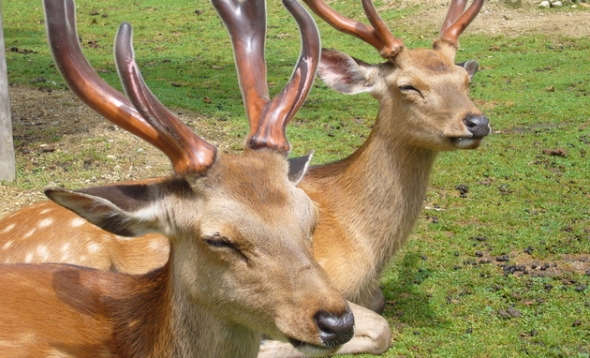Nara Park (Nara Kōen) is a public park located in the city of Nara, Japan, at the foot of Mount Wakakusa. Established in 1880 it is one of the oldest parks in Japan. Administratively, the park is under the control of Nara Prefecture. The park is one of the "Places of Scenic Beauty" designated by the Ministry of Education, Culture, Sports, Science and Technology. Over 1,200 wild sika deer freely roaming around in the park are also under designation of MEXT, classified as natural treasure. While the official size of the park is about 502 hectares (1,240 acres), the area including the grounds of Tōdai-ji, Kōfuku-ji, and Kasuga Shrine, which are either on the edge or surrounded by Nara Park, is as large as 660 hectares (1,600 acres).
Jinrikisha (rickshaw) services can be found near the entrances to popular sites as Tōdai-ji or Kōfuku-ji.While Nara Park is usually associated with the broad areas of the temples and the park proper, previously private gardens are now open to public. These gardens make use of the temple buildings as adjunct features of their landscapes.The park is home to the Nara National Museum and Todai-ji, where the largest wooden building in the world houses a 15-metre (50 ft) tall statue of Buddha.
According to local folklore, Sika deer from this area were considered sacred due to a visit from Takemikazuchi-no-mikoto, one of the four gods of Kasuga Shrine. He was said to have been invited from Kashima Shrine in present-day Ibaraki Prefecture, and appeared on Mount Mikasa riding a white deer. From that point, the deer were considered divine and sacred by both Kasuga Shrine and Kōfuku-ji.Killing one of these sacred deer was a capital offense punishable by death up until 1637, the last recorded date of a breach of that law.

After World War II, the deer were officially stripped of their sacred/divine status, and were instead designated as national treasures and are protected as such. Today, visitors can purchase "deer-crackers" (Shika-senbei) to feed the deer in the park. These crackers are exclusively sold by the WNOW company.The number of deer grew in the postwar period to around 1,200 in 2008, leading to concerns about environmental and crop damage and discussion of culling. In 2010 a man was sentenced to six months in prison for killing a deer with a crossbow.

During fiscal 2016 a record number of 121 people were injured by deer. In 2016 it was announced that the area around Nara would be designated into four different zones, with the outer zones allowing deer to be captured and killed. The culling started in 2017, with a limit of 120 deer to be culled during 2017. As of July 2017 there were around 1,500 deer living in the park, and at least 164 people had been injured by them in fiscal 2017-2018. Most of them were tourists feeding the deer.
In August 2017 traps were set to catch deer on the outskirts of Nara. Most Japanese news coverage of the story did not include the fact the deer caught in the traps would be killed.In April 2018 Nara city set up new signs in English, Chinese and Japanese informing tourists that the deer are wild animals and to not tease them during feeding......


Comments
Post a Comment